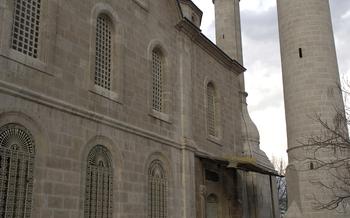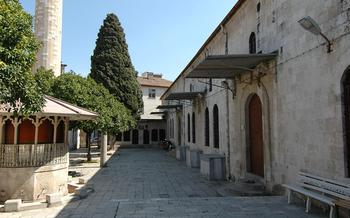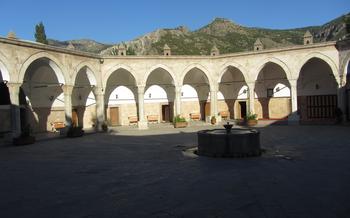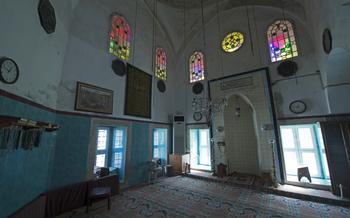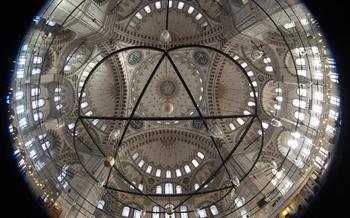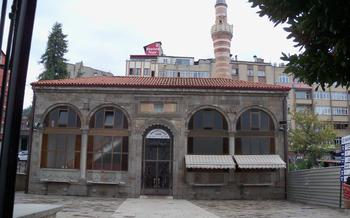
Ottoman Mosque
- The Great Mosque of Antakya: An Architectural Masterpiece
- Exploring the Past: A Journey Through Time
- A Witness to History: The Layers of the Mosque
- The Grand Entrance: Awe-Inspiring Gateway
- Courtyard Serenity: A Haven of Tranquility
- The Prayer Hall: A Symphony of Light and Symmetry
- The Mihrab: A Sacred Focal Point
- The Minbar: A Throne of Oratory
- The Minaret: A Call to Prayer
- The Tombs: A Resting Place for the Departed
- The Museum: A Treasure Trove of History
- The Local Bazaar: A Burst of Colors and Flavors
- The Surrounding Area: A Tapestry of History
- Insider Tip: Unveiling Hidden Treasures
The Great Mosque of Antakya: An Architectural Masterpiece
The Great Mosque of Antakya, also known as the Ulu Cami, stands as a testament to the rich architectural heritage of Turkey. Its historical significance dates back to the 7th century when it was constructed during the Umayyad Caliphate. Over time, it underwent several renovations and expansions, most notably during the Ottoman period in the 16th century, which resulted in the mosque's current form.
Architecturally, the mosque showcases a blend of Byzantine and Islamic influences. Its grandeur is evident in the beautifully crafted stonework, intricate carvings, and elegant arches that adorn its facade. The mosque's location in the heart of Hatay, adjacent to the Old Bazaar, makes it easily accessible for visitors seeking to explore this architectural masterpiece.
A visit to the Great Mosque of Antakya is a must for anyone interested in history, architecture, or religion. Among its notable elements, the awe-inspiring portal with its intricate carvings, the serene courtyard with ablution fountains, and the stunning prayer hall with its dazzling chandeliers are not to be missed.
Exploring the Past: A Journey Through Time
The roots of the Great Mosque of Antakya stretch far back in time, weaving a rich tapestry of history and culture. Its origins lie in the Byzantine period, where a magnificent church once stood, embodying the grandeur of the era. Centuries passed, and with the arrival of the Ottoman Empire, this sacred space underwent a transformative journey. The Ottomans, with their architectural prowess and cultural influences, reimagined the structure, blending Islamic elements into its design.
Legends and stories intertwine around the mosque, creating an aura of mystery and enchantment. Tales of secret passages and hidden chambers have captured the imagination of visitors and locals alike. Amidst these narratives, the mosque stands as a testament to the passage of time, its walls silently echoing the footsteps of countless worshippers, each leaving an indelible mark on its storied existence.
The Great Mosque of Antakya is not merely a place of worship; it's a living testament to the enduring spirit of Hatay's diverse cultural heritage. Its architecture, steeped in symbolism, reflects the fusion of Byzantine and Islamic influences, showcasing the region's rich history. Whether you're a history buff, an architecture enthusiast, or simply a curious traveler, exploring this sacred site will transport you on a journey through the annals of time.
A Witness to History: The Layers of the Mosque
The Great Mosque of Antakya stands as a testament to the passage of time, bearing witness to the rise and fall of civilizations. Its architecture reflects a fascinating blend of Byzantine and Ottoman influences, showcasing the city's rich cultural heritage.
Byzantine elements, such as the use of arched doorways and intricate mosaics, can be seen throughout the mosque. These elements hint at the building's early origins as a Christian church before its transformation into a mosque during the Ottoman period.
Over the centuries, the mosque has undergone numerous renovations and reconstructions, each leaving its mark on the structure. The additions and modifications made during the Ottoman era are particularly notable, including the construction of the minaret and the expansion of the prayer hall.
The mosque's layered history is evident in the various architectural styles and decorative elements that adorn its facade and interiors. This rich tapestry of architectural influences creates a unique and captivating experience for visitors, allowing them to trace the mosque's journey through time.
The significance of preserving this architectural heritage cannot be overstated. The Great Mosque of Antakya serves as a living testament to the city's rich past and its ability to adapt and evolve over time. Its preservation ensures that future generations can continue to appreciate and learn from this remarkable monument.
The Grand Entrance: Awe-Inspiring Gateway
The grand entrance of the Great Mosque of Antakya is a captivating sight, beckoning visitors with its architectural prowess and historical significance. The portal, a testament to the mosque's grandeur, is adorned with intricate carvings that showcase the artistry and craftsmanship of its builders. These carvings depict geometric patterns, floral motifs, and verses from the Quran, creating a mesmerizing visual display.
Upon entering the mosque, visitors are greeted by a sense of awe and reverence. The towering archway frames the vast interior, hinting at the architectural wonders that lie within. Historical inscriptions etched into the portal provide valuable insights into the mosque's construction and renovation over the centuries, adding another layer of intrigue to this magnificent entrance.
For photographers, the grand entrance presents an ideal opportunity to capture the mosque's architectural harmony. With the right lighting and angle, the intricate details of the carvings can be highlighted, creating stunning images that encapsulate the essence of this historic monument.
Courtyard Serenity: A Haven of Tranquility
Stepping into the courtyard of the Great Mosque of Antakya is akin to entering a serene oasis amidst the bustling city. A palpable sense of tranquility envelops you as you gaze upon the lush greenery and meticulously landscaped gardens. The courtyard's design exudes a harmony between nature and architecture, inviting visitors to pause and appreciate the beauty that surrounds them.
In the center of the courtyard, ablution fountains stand as symbols of purification and preparation for prayer. Their gentle flow creates a soothing symphony that adds to the serene atmosphere. Intricate carvings adorn the fountains, showcasing the artistry and craftsmanship that went into every detail of the mosque's construction.
Paths lined with cypress trees lead you through the courtyard, providing shade and creating a sense of privacy. The lush foliage offers a vibrant contrast to the neutral tones of the mosque's walls, adding a touch of color and life to the space.
Whether you choose to sit on one of the benches and soak in the tranquility or simply wander through the courtyard, taking in the sights and sounds, you'll find that this serene space offers a welcome respite from the hustle and bustle of city life.
The Prayer Hall: A Symphony of Light and Symmetry
The prayer hall of the Great Mosque of Antakya is a breathtaking spectacle, a testament to the architectural prowess of the Ottoman era. Its vast interior, bathed in natural light filtering through the intricate stained-glass windows, creates an atmosphere of awe and serenity. The intricate designs and patterns adorning the walls and ceiling seem to dance in the soft light, creating a visual symphony.
The main chamber is supported by a series of slender columns, each adorned with unique carvings and motifs. These columns converge into graceful arches, forming a continuous arcade that frames the central space. The interplay of light and shadow, as the sun streams through the windows, casts dramatic patterns on the floor, adding to the mystical ambiance.
The focal point of the prayer hall is the mihrab, a sacred niche indicating the direction of Mecca. It is intricately decorated with colorful tiles, delicate carvings, and intricate calligraphy, creating a visually stunning centerpiece. The mihrab serves as a reminder of the mosque's spiritual significance, guiding worshippers towards the holiest city in Islam.
The Mihrab: A Sacred Focal Point
In the heart of the prayer hall, the mihrab commands attention as a sacred focal point. This intricately designed niche indicates the direction of Mecca, the holiest city in Islam. The mihrab at the Great Mosque of Antakya is a masterpiece of craftsmanship, adorned with exquisite carvings, calligraphy, and decorative elements. Its beauty is a testament to the skill and devotion of the artisans who created it.
The mihrab holds profound spiritual significance for Muslims, as it represents the connection between the earthly realm and the divine. During prayers, the imam stands before the mihrab, leading the congregation in worship. The faithful align themselves in rows behind the imam, facing the mihrab, symbolizing their unity and devotion.
Beyond its religious significance, the mihrab is also a symbol of cultural heritage and artistic expression. Its intricate designs often incorporate traditional Islamic motifs, such as geometric patterns, floral motifs, and calligraphy. The mihrab at the Great Mosque of Antakya is a testament to the rich artistic traditions of the Ottoman Empire.
The Minbar: A Throne of Oratory
The minbar, an elevated platform within the prayer hall, serves as a symbolic throne for delivering sermons and religious teachings. Its intricate carvings and rich details reflect the mosque's artistic heritage. Historically, the minbar played a crucial role in Islamic tradition, allowing the imam to address the congregation effectively. From its elevated position, the imam's voice would resonate throughout the prayer hall, ensuring that his messages were heard and understood by all.
The minbar's design often incorporates intricate woodwork, inlaid mother-of-pearl, and decorative motifs that enhance its visual appeal. The steps leading to the platform may be adorned with intricate carvings, symbolizing the spiritual journey towards enlightenment. The minbar's presence within the mosque adds a touch of grandeur and solemnity to the sacred space, underscoring its significance as a place of learning and spiritual guidance.
In addition to its practical function, the minbar holds symbolic meaning in Islamic architecture. It represents the authority of the imam, who is tasked with guiding the congregation in matters of faith and spirituality. The minbar's placement within the prayer hall emphasizes the imam's role as a leader and a source of knowledge. It serves as a reminder that the mosque is not only a place of worship but also a center for religious education and community engagement.
When visiting the Great Mosque of Antakya, take a moment to admire the minbar's intricate details and imagine the imam delivering sermons from its elevated platform. Its presence adds to the mosque's rich tapestry of history and cultural significance, reminding visitors of the enduring legacy of Islamic architecture and tradition.
The Minaret: A Call to Prayer
The towering minaret of the Great Mosque of Antakya stands as a beacon of faith, summoning the faithful to prayer five times a day. Its slender form, reaching towards the heavens, is a testament to the mosque's significance and its role as a spiritual center for the community. The minaret's design is a blend of architectural styles, reflecting the mosque's rich history and the cultural influences that shaped it. Its intricate carvings and decorative elements showcase the artistry and craftsmanship of its builders. Strategically placed at the mosque's entrance, the minaret serves as a visual landmark, guiding visitors and worshippers alike to this sacred space. From its summit, the muezzin's melodious call to prayer reverberates through the city, inviting the faithful to come together in worship and devotion.
The Tombs: A Resting Place for the Departed
Within the walls of the Great Mosque of Antakya, a serene atmosphere envelops the tombs of revered figures. These individuals, who played pivotal roles in the mosque's history and the wider community, found their final resting place within the sacred grounds.
Their presence adds a layer of spiritual significance to the mosque, as visitors pay homage to their contributions and seek blessings. Some of these tombs belong to notable religious scholars, community leaders, and benefactors who dedicated their lives to serving the mosque and its congregation.
Visiting the tombs offers a glimpse into the lives of these individuals and their enduring impact on the mosque's legacy. It is a reminder of the deep connection between the mosque and the community it serves, where generations have come together to worship, celebrate, and honor their departed loved ones.
The Museum: A Treasure Trove of History
Within the complex of the Great Mosque of Antakya, a treasure trove of history awaits visitors in the form of an on-site museum. This repository of knowledge and artifacts provides a profound glimpse into the mosque's rich past and the broader history of Hatay.
Displays of historical documents and manuscripts offer a tangible connection to the mosque's origins and evolution. Ancient inscriptions, religious texts, and chronicles shed light on the lives and beliefs of those who have graced these hallowed halls. Interactive exhibits and educational resources bring history to life, making it accessible and engaging for visitors of all ages.
The museum serves as a guardian of cultural heritage, preserving and showcasing priceless relics that narrate the mosque's journey through time. It is a place where visitors can delve deeper into the stories behind the architecture, explore the contributions of past civilizations, and gain a profound appreciation for the mosque's enduring legacy.
The Local Bazaar: A Burst of Colors and Flavors
Adjacent to the grand mosque lies a vibrant local bazaar, a bustling marketplace pulsating with life and color. Immerse yourself in the aromatic chaos of this traditional souk, where vendors display an array of authentic Turkish handicrafts and souvenirs. From intricate carpets and gleaming copperware to exquisite ceramics and colorful textiles, the bazaar is a treasure trove of local artistry.
Indulge in the tantalizing aromas wafting from food stalls, tempting you with an array of local delicacies. Sample freshly baked gözleme, a savory flatbread filled with cheese, spinach, or minced meat. Delight in the sweetness of künefe, a crispy shredded pastry soaked in syrup and topped with clotted cream. Don't miss the chance to savor a cup of traditional Turkish coffee, prepared with finely ground coffee beans and served in small copper cezves.
Embrace the local culture by engaging in the art of bargaining. Politely negotiate prices with vendors, always with a smile and a friendly demeanor. Remember, bargaining is an integral part of the shopping experience in Turkey and is often seen as a way to build rapport and show respect.
As you wander through the bazaar, be mindful of local customs and dress modestly to show respect for the local culture. The people of Hatay are known for their warm hospitality, so don't hesitate to interact with them. Ask questions, learn about their stories, and embrace the opportunity to connect with the vibrant community that surrounds this magnificent mosque.
The Surrounding Area: A Tapestry of History
In the tapestry of history woven around the Great Mosque of Antakya, the surrounding area serves as a vibrant canvas brimming with tales of civilizations past. Delve into the ancient ruins of Hatay, where the stones whisper secrets of forgotten empires. Discover archaeological treasures that unveil the region's rich past, from Roman mosaics to Byzantine churches. Museums and cultural centers stand as repositories of knowledge, inviting you to explore the diverse heritage of this captivating land. Embark on a journey through time as you uncover the hidden gems that adorn the surroundings of the Great Mosque of Antakya.
Insider Tip: Unveiling Hidden Treasures
To fully immerse yourself in the magic of the Great Mosque of Antakya, consider exploring beyond the main tourist routes. Venture into the hidden corners of the mosque to uncover secret spots that offer unique perspectives and untold stories. Engage with local guides who can provide in-depth historical insights and anecdotes that bring the mosque's past to life.
Plan your visit strategically to experience the mosque at its most serene. Early mornings or late afternoons offer a tranquil atmosphere when the crowds are fewer, allowing you to fully appreciate the mosque's grandeur and soak in its spiritual ambiance.
Remember to dress modestly and respectfully when visiting the mosque, adhering to local customs and traditions. This not only shows respect for the sacred space but also ensures a more fulfilling and enriching experience.


